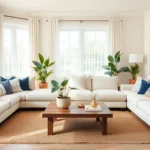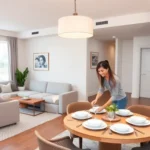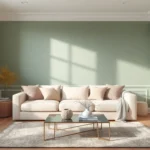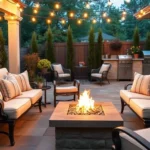Your living room serves as the heart of your home where family gatherings unfold and memories take shape. We understand that creating the perfect space requires balancing style comfort and functionality while reflecting your unique personality. Whether you’re working with a cozy apartment or a spacious family room the right interior design choices can transform your living space into something truly extraordinary.
From selecting the perfect color palette to arranging furniture that maximizes both flow and comfort we’ll guide you through proven strategies that interior designers use to create stunning living rooms. You don’t need an unlimited budget or professional help to achieve magazine-worthy results.
We’ve compiled the most effective home interior ideas that’ll help you reimagine your living room without very costly. These practical yet stylish answers will turn your space into the welcoming sanctuary you’ve always envisioned where every element works together harmoniously.
Choose the Perfect Color Palette for Your Living Room
Color sets the foundation for your entire living room design and influences the mood of your space. We’ll explore three distinctive approaches that’ll help you create a cohesive and visually appealing environment.
Neutral Tones for Timeless Appeal
Neutral colors like beige, cream, gray, and soft white create a versatile backdrop that never goes out of style. These calming hues work beautifully with any furniture style and allow you to switch up accessories without worrying about clashing colors.
Light gray walls paired with cream furniture pieces offer endless decorating possibilities. We recommend starting with a warm beige or soft gray as your base color, then layering in different textures through throw pillows, blankets, and area rugs.
Natural elements like wood tones and stone accents complement neutral schemes perfectly. Consider adding warmth through rich wooden coffee tables or natural fiber baskets that enhance the organic feel of your space.
Bold Accent Colors for Personality
Strategic pops of vibrant color inject energy and reflect your personal style without overwhelming the room. Deep emerald green, navy blue, or rich burgundy create stunning focal points when used thoughtfully.
We suggest using the 60-30-10 rule: 60% neutral base, 30% secondary color, and 10% bold accent. Paint one accent wall in a dramatic shade like deep teal or charcoal, then echo that color in smaller accessories throughout the room.
Colorful artwork, statement pillows, or a vibrant area rug serve as excellent accent pieces. These elements allow you to experiment with trends while keeping larger furniture investments neutral and long lasting.
Monochromatic Schemes for Sophistication
Working within one color family creates an elegant and cohesive look that feels professionally designed. Various shades of blue, from powder to navy, or different gray tones from light silver to charcoal demonstrate this approach beautifully.
Layer different textures and materials to prevent a monochromatic room from feeling flat or boring. Combine velvet cushions with linen curtains and leather furniture all in similar blue tones for visual interest.
We recommend varying the intensity of your chosen color throughout the space. Use lighter shades on walls, medium tones for larger furniture pieces, and deeper hues for accent items like vases or picture frames.
Select Statement Furniture Pieces That Define Your Space

Choosing the right furniture pieces transforms our living room from ordinary to extraordinary. Statement furniture creates visual anchors that define our space and reflect our personal style.
Invest in a Quality Sofa as Your Focal Point
Quality sofas serve as the cornerstone of our living room design. We recommend selecting a sofa that balances comfort with visual appeal, as it’ll anchor the entire space. Statement sofas featuring bold fabrics or unique silhouettes add personality while maintaining functionality. Elegant velvet sofas introduce luxury through their plush texture and rich appearance.
Size matters when choosing our focal point sofa. We should measure our space carefully to ensure the sofa fits proportionally without overwhelming the room. Sectional sofas work well in larger spaces, while apartment-sized sofas suit compact living areas perfectly.
Add Functional Storage Answers
Storage answers keep our living room organized without sacrificing style. We can incorporate furniture pieces that serve dual purposes while maintaining aesthetic appeal. Storage ottomans provide comfortable seating while hiding clutter like blankets, games, or seasonal items.
Side tables with built-in drawers offer discrete storage options. We recommend choosing pieces that complement our existing furniture while providing space for remotes, coasters, and small accessories. Built-in shelving units create vertical storage that displays books, decorative objects, and personal collections beautifully.
Incorporate Multi-Purpose Furniture
Multi-purpose furniture maximizes our living space efficiency. We can select pieces that adapt to different needs throughout the day, making our room more versatile. Sofa beds transform our living room into guest accommodations when needed, perfect for small apartments or homes without dedicated guest rooms.
Coffee tables with hidden storage compartments keep essentials within reach. We should look for designs that open to reveal space for magazines, electronics, or children’s toys. Nesting tables provide flexible surface options that tuck away when not needed, offering adaptability for entertaining or daily use.
Create Visual Interest with Strategic Lighting Design
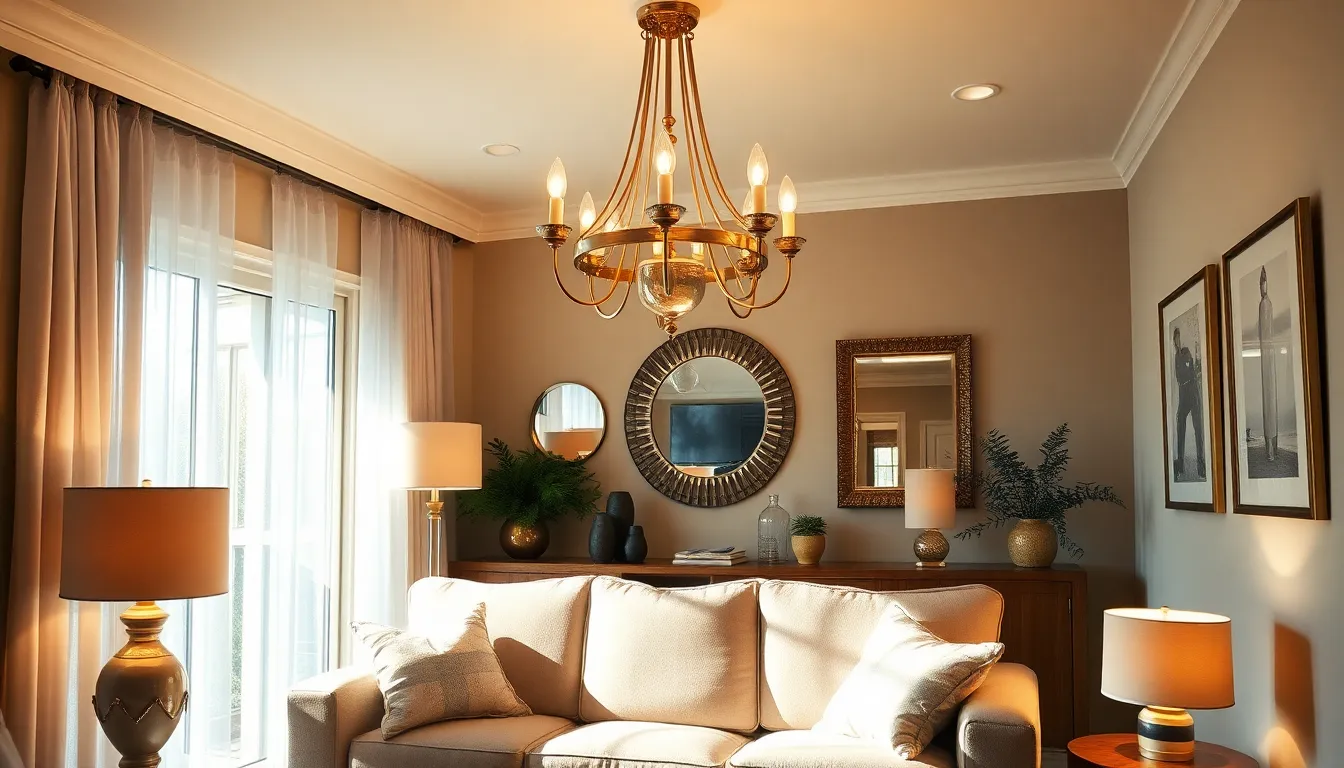
Smart lighting choices can transform our living room from ordinary to extraordinary. We’ll explore how different lighting techniques work together to create depth and visual appeal.
Layer Different Types of Lighting
Ambient lighting forms the foundation of our lighting design by providing overall illumination throughout the room. We can achieve this through overhead fixtures like recessed lights or ceiling-mounted chandeliers that distribute light evenly across the space.
Task lighting focuses on exact activities and areas where we need concentrated illumination. Table lamps positioned beside reading chairs and floor lamps next to sofas create perfect reading nooks while adding warmth to our living space.
Accent lighting highlights our room’s best features and creates dramatic focal points. Picture sconces illuminate artwork or bookshelves with a softer glow, while strategically placed spotlights can showcase architectural details or decorative collections.
Chandeliers serve as statement pieces that tie our room’s theme together while providing both ambient and accent lighting. We can choose from modern geometric designs, traditional crystal fixtures, or rustic farmhouse styles to match our decor.
Use Natural Light to Your Advantage
Mirrors amplify natural sunlight when we position them opposite windows, effectively doubling the amount of daylight in our living room. Large mirrors or collections of smaller mirrors create the illusion of expanded space while maximizing brightness.
Sheer curtains allow filtered sunlight to enter our room while maintaining privacy during daytime hours. We can layer them with heavier drapes for nighttime privacy and light control flexibility.
Light colored walls reflect natural light more effectively than dark surfaces, helping to brighten our entire living space. Pale neutrals, soft whites, and cream tones work best for maximizing the impact of available daylight.
Window treatments should complement rather than block our natural light sources. Hanging curtain rods higher and wider than the actual window frame creates the appearance of larger windows while allowing maximum light penetration.
Add Ambient Lighting for Cozy Atmosphere
Soft lamp shades made from glass or paper materials diffuse harsh light and create a gentle glow throughout our living room. These materials filter the light beautifully, eliminating stark shadows and creating inviting warmth.
Dimmer switches give us complete control over lighting intensity, allowing us to adjust the mood from bright and energetic to soft and relaxing. We can install dimmers on overhead fixtures, wall sconces, and even some table lamps for maximum flexibility.
Multiple light sources at different heights create layers of illumination that feel more natural and welcoming than single overhead fixtures. Combining floor lamps, table lamps, and wall sconces provides options for various activities and times of day.
Warm light bulbs with temperatures between 2700K and 3000K create the coziest atmosphere for our living room, mimicking the golden tones of sunset and candlelight.
Transform Walls with Creative Decorative Elements

We can dramatically enhance our living room’s visual appeal by transforming blank walls into stunning focal points. Creative wall treatments add personality and depth while maintaining the cohesive design we’ve established with our color palette and furniture choices.
Gallery Wall Arrangements
Gallery Wall Arrangements allow us to showcase personal style through curated collections of art and photographs. We should choose a mix of frame styles and sizes to add visual interest, combining photographs, artwork, and decorative items for maximum impact.
Creating themed collections helps establish cohesion throughout our display. Travel destinations or family portraits work exceptionally well as unifying themes that tell our personal story.
Balanced composition ensures our gallery wall becomes a true design statement. We need to distribute frames thoughtfully across the wall space, creating visual harmony that draws the eye naturally from piece to piece.
Textured Wall Treatments
Textured wallpaper transforms plain walls into sophisticated design elements. Grasscloth or print-based textured wallpapers that mimic natural materials like wood or stone create depth without overwhelming our existing decor.
Faux plastered walls offer an elegant solution for adding architectural interest. We can achieve this plastered look using joint compound, Venetian plaster paint, or limewash paint to create stunning depth and visual texture.
3D wall panels provide a modern approach to wall decoration. These contemporary panels create sleek, geometric patterns that complement minimalist or modern living room designs perfectly.
Strategic Mirror Placement
Reflecting natural light maximizes our room’s brightness and spaciousness. We should place mirrors opposite windows to amplify natural light and create the illusion of a larger, more open living space.
Creating depth becomes effortless with strategic mirror positioning. Smaller rooms benefit tremendously from mirrors that create visual depth, making cramped spaces feel more expansive and inviting.
Aesthetic enhancement transforms mirrors from functional items into stunning decorative elements. Decorative mirrors add elegance and style while serving practical purposes, making them perfect dual-function design choices for our living room walls.
Incorporate Textures and Patterns for Depth
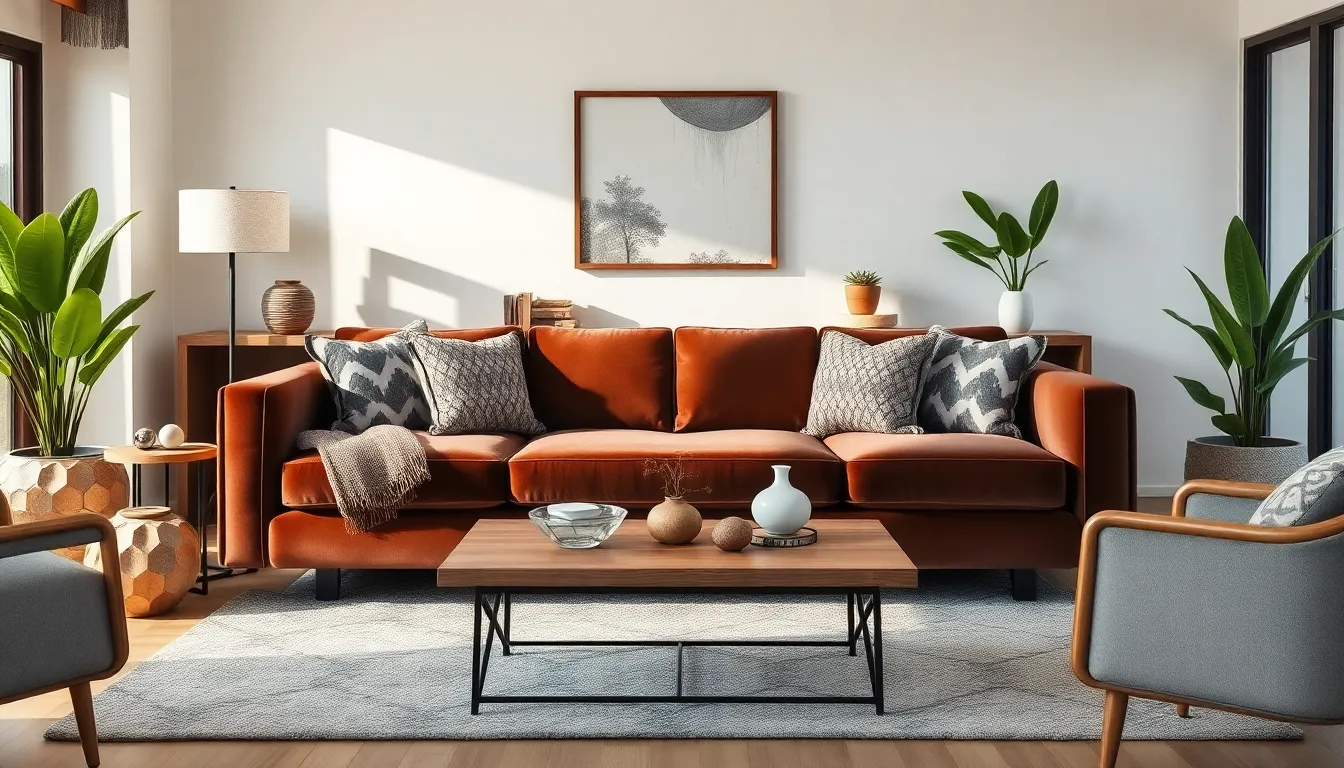
Textures and patterns create visual complexity that transforms a flat living room into a ever-changing, captivating space. Layering different materials and designs adds tactile interest while maintaining the comfort and style we’ve established through color and furniture choices.
Mix Different Fabric Textures
Combining contrasting fabric textures creates immediate visual and tactile depth in our living room design. We recommend pairing plush velvet with chunky knits, smooth linen, and faux fur to establish contrast while maintaining comfort throughout the space. Layering these materials strategically—such as placing a velvet sofa alongside woolen throw pillows and a textured rug—adds complexity without creating visual overwhelm.
Velvet surfaces provide luxurious softness that contrasts beautifully with rougher textures like jute or burlap. We suggest incorporating velvet through accent pillows, curtains, or upholstered furniture pieces to introduce sophistication. Chunky knit throws and cable-knit pillows offer cozy textures that invite touch and create warmth in seating areas.
Smooth linen fabrics balance heavier textures while adding breathable, casual elegance to our design scheme. We often use linen for window treatments, throw pillows, or lampshades to create visual breathing room between more dramatic textures. Faux fur accents through small pillows or throws introduce unexpected luxury without overwhelming the overall composition.
Balance Patterns and Solids
Balancing patterns with solid colors prevents visual chaos while maintaining design interest throughout our living room. We recommend selecting a primary color palette first, then varying pattern scales within that cohesive scheme to create harmony. Large patterns work best on major pieces like curtains or sofas, while smaller geometric or striped designs complement through cushions and area rugs.
Bold floral patterns on important furniture pieces serve as statement elements that anchor our design scheme. We suggest limiting large patterns to one or two key pieces per room, using solid-colored walls and furniture as visual anchors that provide rest areas for the eye. Geometric patterns in smaller scales add contemporary flair without competing with larger design statements.
Solid colors create essential breathing space that prevents pattern overload in our living room design. We use solid-colored furniture pieces, wall treatments, or large textiles to balance patterned elements and maintain visual clarity. Striped textiles offer transitional patterns that bridge bold designs with solid colors effectively.
Add Natural Elements
Natural materials bring warmth and organic beauty that enhances our living room’s overall ambiance. We incorporate wood, stone, and woven materials through furniture selections, wall panels, and decorative accessories to create connection with nature. Live plants and wooden coffee tables introduce life and authentic texture that synthetic materials cannot replicate.
Wood elements provide grounding warmth through coffee tables, side tables, and decorative bowls or sculptures. We recommend mixing wood tones rather than matching everything perfectly, as varied wood grains create more authentic, lived-in appeal. Stone accents through decorative objects, plant containers, or accent walls add substantial texture and natural beauty.
Textured wall treatments elevate our living room design while creating compelling focal points throughout the space. We suggest lime wash finishes, wood cladding, or patterned wallpaper to add architectural interest and depth. Woven materials like rattan, jute, or bamboo introduce organic patterns and textures through baskets, light fixtures, or furniture pieces that complement our natural design elements.
Optimize Your Living Room Layout for Flow and Function
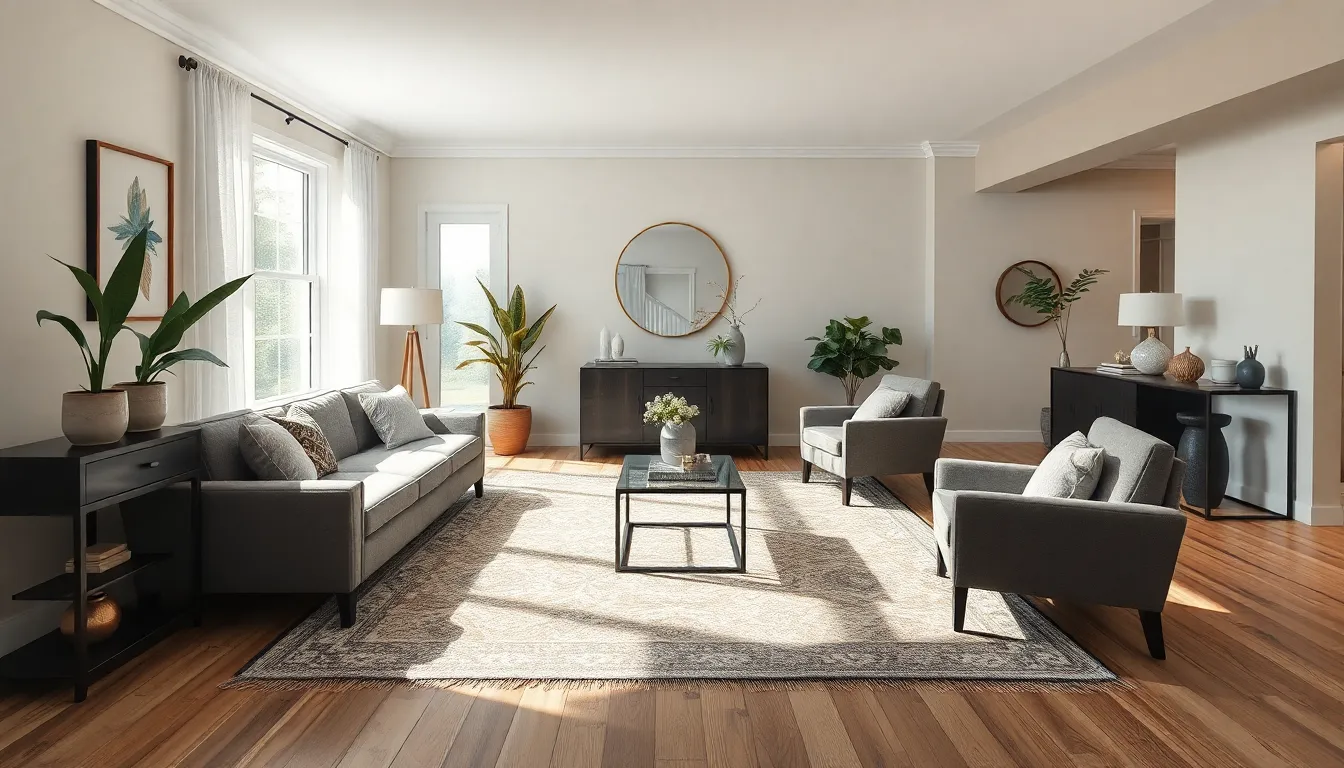
Strategic furniture placement transforms your living room into a harmonious space where comfort meets functionality. We’ll explore essential layout principles that enhance both movement and social interaction throughout your space.
Define Conversation Areas
Creating intimate seating arrangements encourages meaningful connections between family members and guests. Position sofas and chairs to face each other at comfortable angles, typically 8 to 10 feet apart for optimal conversation distance.
Anchor each seating group with area rugs that define the space boundaries. Choose rugs large enough to fit all front furniture legs on the surface, creating visual cohesion and separating different zones within your living room.
Use furniture pieces as natural room dividers to establish distinct areas without walls. Console tables behind sofas or strategically placed bookshelves can separate conversation zones while maintaining an open feel throughout the space.
Create Clear Pathways
Maintain 3 feet of walking space through your living room’s main traffic routes to ensure comfortable movement. This measurement allows two people to pass each other easily without feeling cramped or having to navigate around furniture obstacles.
Position major furniture pieces away from natural walkways to prevent bottlenecks during daily activities. Keep the center of your room relatively open, allowing family members to move freely between different areas and access points like doorways or windows.
Angle furniture slightly toward the room’s interior rather than pushing everything against walls. This technique creates more intimate seating arrangements while naturally guiding foot traffic around the perimeter of your conversation areas.
Consider Traffic Patterns
Map out daily movement patterns before finalizing your furniture placement to identify high traffic zones. Consider how family members typically enter the room, where they sit most often, and which areas they access regularly throughout the day.
Place functional furniture along natural pathways to serve dual purposes without obstructing flow. Console tables behind sofas can provide surface space for drinks or decor while subtly directing traffic around seating areas rather than through them.
Avoid creating furniture arrangements that force people to walk behind seated guests to reach other areas of the room. Position chairs and sofas so that pathways flow around conversation areas, maintaining both privacy for those seated and convenience for those moving through the space.
Accessorize with Purpose and Style
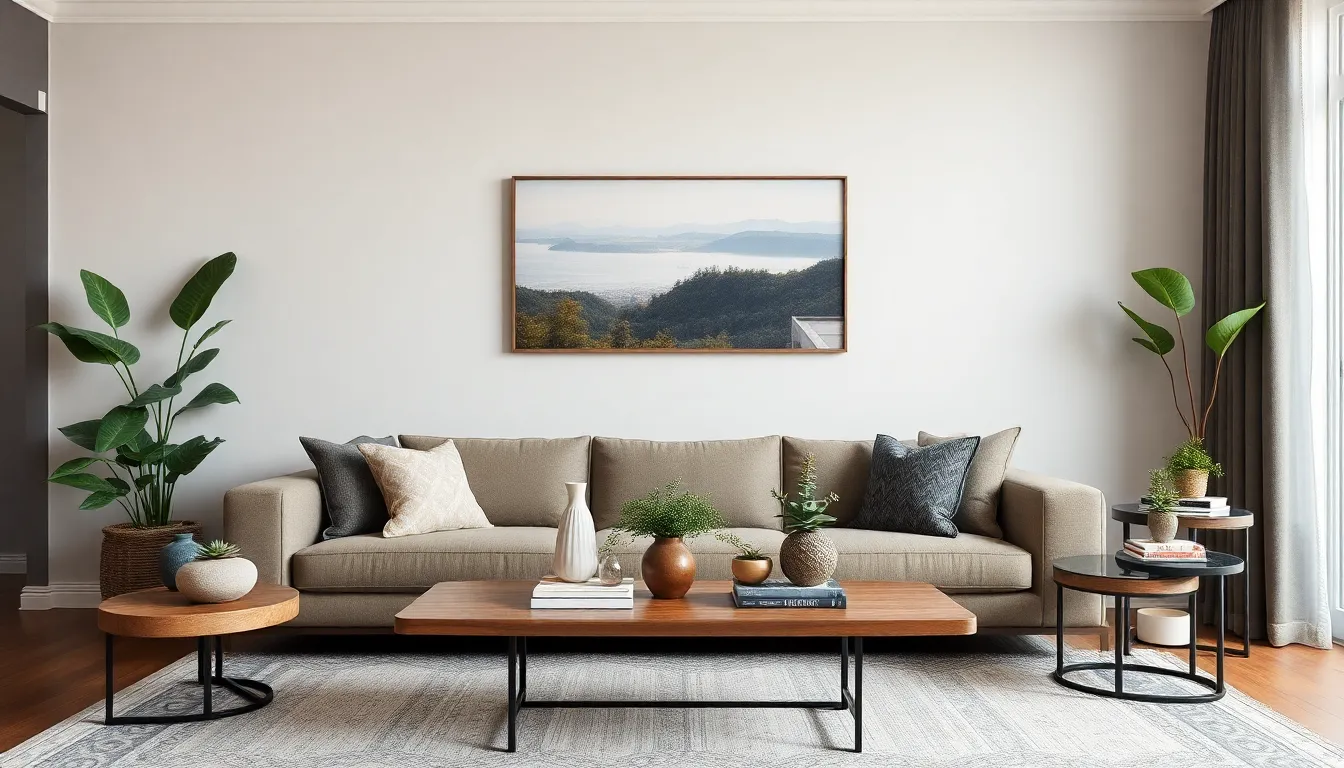
Smart accessorizing transforms our living room from simply furnished to thoughtfully curated. We’ll focus on selecting pieces that serve dual purposes while improving our space’s aesthetic appeal.
Choose Meaningful Decorative Objects
Personal touches make our living room uniquely ours through carefully selected meaningful items. Family photos, heirlooms, and collectibles create emotional connections that guests immediately notice when they enter our space.
Cultural elements add depth and storytelling to our home interior design. We can incorporate pieces that reflect our heritage, travel experiences, or personal interests like vintage pottery from local artisans or handwoven textiles from meaningful journeys.
Quality over quantity ensures our decorative objects make genuine impact. Rather than cluttering surfaces with many small items, we should select fewer pieces that truly resonate with our personal style and family history.
Style Coffee Tables and Side Tables
Mixing materials creates visual interest that prevents our living room from appearing flat or monotonous. We can combine wood with glass, metal with ceramic, or stone with woven elements to achieve sophisticated layering.
Decorative layering transforms simple surfaces into curated vignettes that draw the eye. Books, vases, sculptures, and candles work together when we vary their heights, textures, and shapes across our table surfaces.
Functional decor serves multiple purposes while maintaining our living room’s visual appeal. Woven baskets provide storage for throws and magazines, while vintage trays corral remote controls and coasters without sacrificing style.
Add Plants for Life and Color
Low maintenance plants bring natural beauty without overwhelming our busy schedules. Succulents, air plants, and snake plants thrive with minimal attention while adding fresh green elements to our living room palette.
Strategic planter selection enhances our overall home interior design scheme. We should choose containers that complement our existing color palette and material choices, whether that’s sleek ceramic for modern spaces or rustic terracotta for bohemian vibes.
Varied plant heights create ever-changing arrangements that fill empty corners and awkward spaces. Tall floor plants like fiddle leaf figs anchor seating areas, while smaller potted herbs or flowering plants add pops of color to side tables and shelving units.
Maximize Small Living Room Spaces
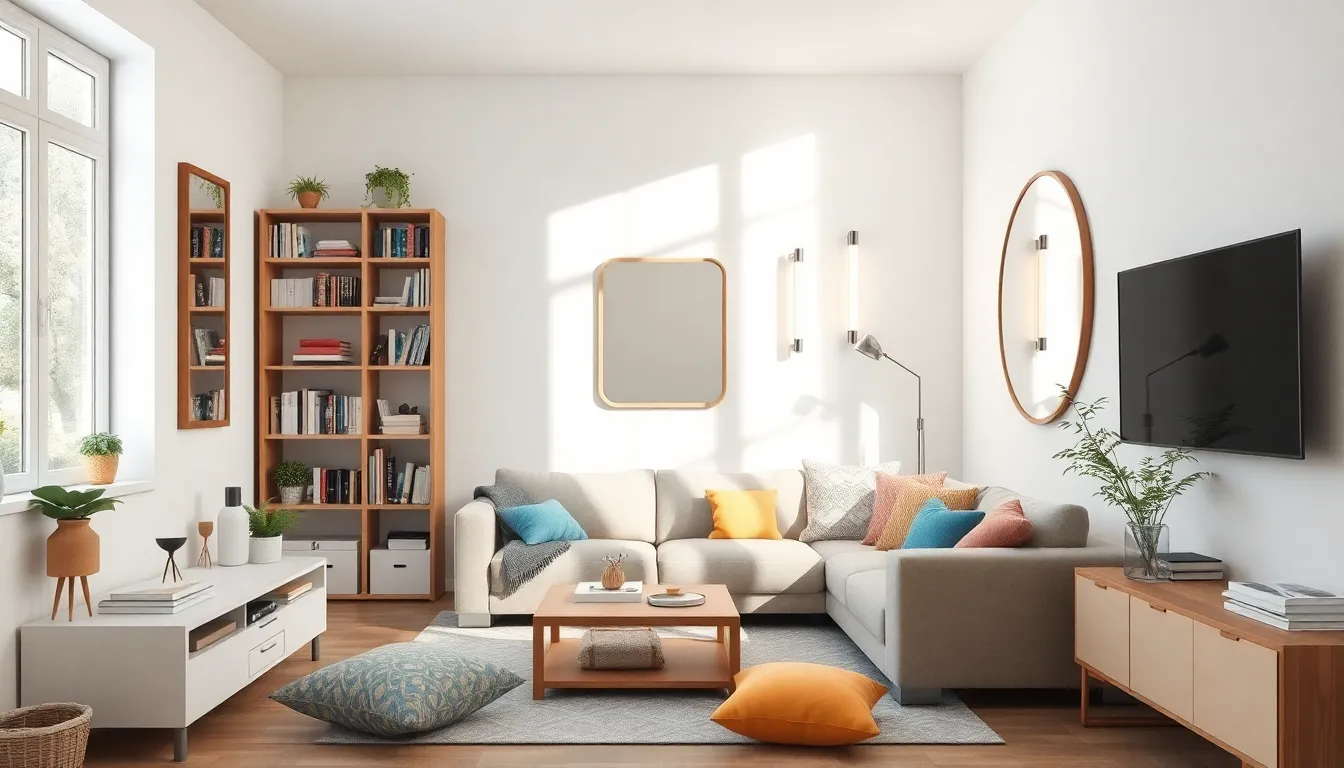
We can transform even the tiniest living room into a spacious, functional sanctuary with smart design strategies. Creating the illusion of space while maintaining comfort requires thoughtful planning and strategic choices.
Use Vertical Space Effectively
Wall-mounted decor elevates our design approach by drawing the eye upward and creating visual height. Large pieces of art, mirrors, or floating shelves mounted at varying heights make our ceilings appear taller than they actually are.
Floor-to-ceiling shelving units maximize storage capacity without consuming valuable floor space. We recommend installing these units in corners or along accent walls to house books, decorative objects, and everyday essentials while keeping our room organized.
Vertical lighting fixtures add both function and style through wall sconces positioned at different levels. These fixtures free up table surfaces while providing layered illumination that enhances our room’s overall brightness.
Choose Light Colors to Open Up the Room
Neutral color palettes reflect natural light more effectively than darker tones, making our small living room feel significantly larger. Light grays, warm whites, and pale beiges create an airy foundation that opens up our space.
Bold accent colors add personality without overwhelming our compact room when used strategically in trim, pillows, or single statement pieces. We suggest limiting bold colors to 20% of our overall palette to maintain visual balance.
Monochromatic light color schemes create seamless flow throughout our living room by eliminating harsh contrasts that can fragment the space. Varying shades of the same light color family creates depth while maintaining spaciousness.
Select Appropriately Sized Furniture
Multipurpose furniture pieces serve double duty in small living rooms through storage ottomans, coffee tables with built-in compartments, and sofa beds. These functional pieces eliminate clutter while providing essential seating and storage answers.
Sectional sofas work surprisingly well in small spaces when paired with high ceilings and positioned away from walls. An appropriately sized sectional can provide ample seating without making our room feel cramped or overcrowded.
Compact furniture maintains visual flow by leaving adequate walking paths and breathing room around each piece. We recommend choosing pieces with exposed legs to create the illusion of more floor space and lighter visual weight.
Blend Modern and Traditional Elements

Creating a living room that merges contemporary design with classic elements allows us to achieve a unique aesthetic that honors both innovation and heritage. This approach lets us build upon existing traditional pieces while introducing fresh, modern touches.
Mix Contemporary and Classic Pieces
Contemporary sofas serve as excellent anchors when paired with traditional furniture elements in our living room design. We can position a sleek, tapered-arm sofa alongside a vintage armchair to create visual contrast that feels intentional rather than mismatched.
Classic accents work beautifully when integrated thoughtfully throughout the space. Incorporating a vintage chandelier above modern seating creates an unexpected focal point, while placing a traditional side table next to contemporary pieces bridges the style gap seamlessly.
Ottoman selections offer practical opportunities to blend eras effectively. We might choose a modern storage ottoman in rich leather to complement classic wooden furniture, creating functional seating that honors both design philosophies.
Balance Clean Lines with Ornate Details
Ornate patterns add traditional character when applied strategically to modern foundations. We can introduce classic damask or paisley designs through area rugs and throw pillows while keeping the primary furniture pieces clean and simple.
Sleek furniture with minimal ornamentation provides the perfect canvas for decorative traditional elements. Modern coffee tables with glass tops allow ornate Persian rugs underneath to shine, while streamlined bookcases showcase vintage decorative objects beautifully.
Upholstery choices create opportunities to merge both aesthetics successfully. We might select a contemporary sectional in solid fabric and layer it with throw pillows featuring traditional embroidery or classic toile patterns.
Create Cohesive Transitions
Color palettes unite disparate design elements when chosen carefully across both modern and traditional pieces. Warm neutrals like cream and taupe work with antique wooden furniture and contemporary metal accents, while soft blues complement both modern ceramics and vintage textiles.
Focal points draw attention strategically while connecting different style elements throughout the room. We can hang a large contemporary art piece above a traditional fireplace mantel, or position a classic sculpture on a modern console table to create visual bridges.
Mood boards help us visualize how various pieces will interact before making final selections. Creating floor plans alongside style boards ensures that our modern dining chairs will complement the traditional dining table, and that traffic flow remains optimal even though mixing furniture heights and proportions.
Establish a Cohesive Design Theme
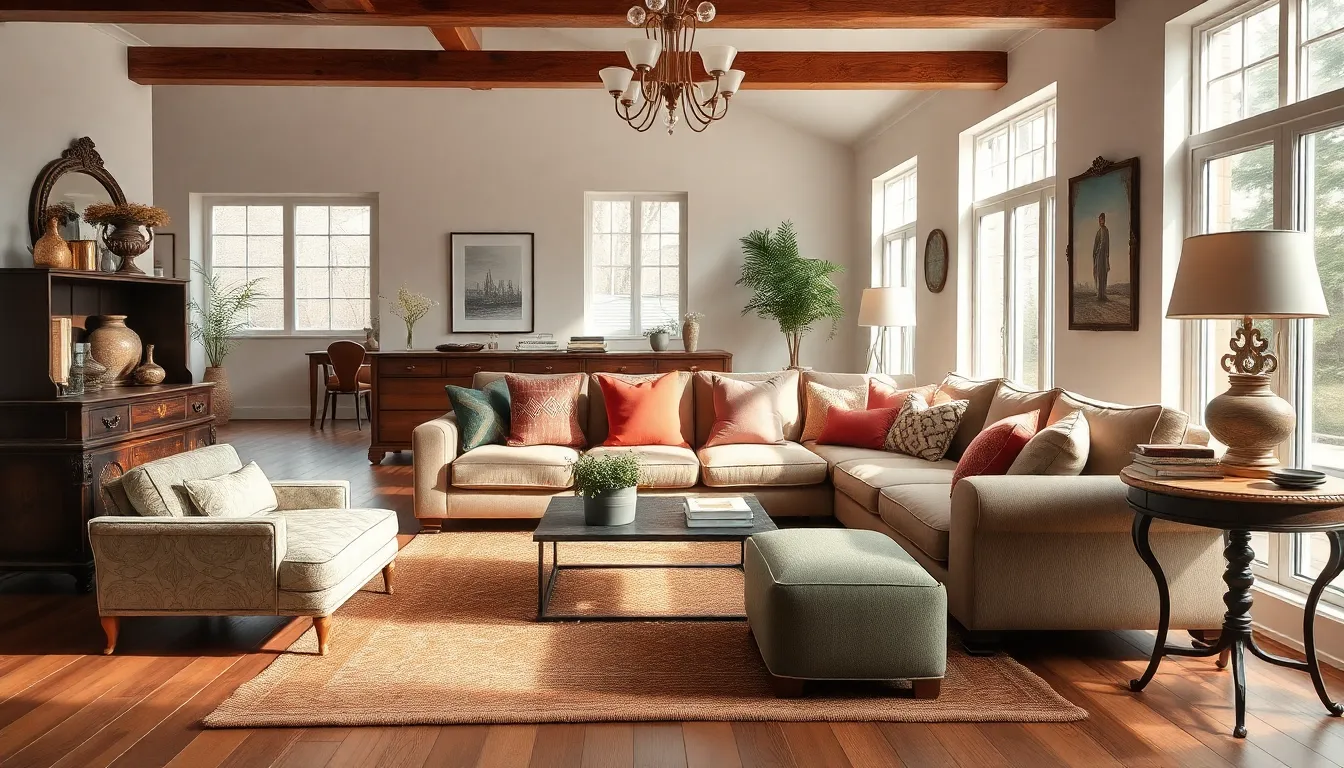
Creating a unified living room design requires selecting a clear theme that guides every decorating decision. We’ll explore three essential steps to establish and maintain design harmony throughout your space.
Define Your Personal Style
Identify your aesthetic preferences by examining colors, textures, and materials that naturally draw your attention. Traditional, modern, cozy, or eclectic themes each offer distinct characteristics that can shape your living room’s personality. We recommend creating a mood board to visualize how different elements work together before making major purchases.
Choose a core color palette of three to five hues that will anchor your design scheme. Expert designers suggest selecting colors you’re genuinely attracted to rather than following trends that may not reflect your taste. This palette should include one dominant color, one secondary shade, and one to three accent colors that complement each other harmoniously.
Mix vintage and new furniture to create visual interest while maintaining your chosen theme. Combining contemporary sofas with antique side tables or modern lighting with traditional artwork adds personality without sacrificing cohesion. Each piece should contribute to your overall aesthetic vision while serving its functional purpose.
Maintain Consistency Throughout
Repeat key design elements across different areas of your living room to create visual flow. Architectural features like trim, millwork, and hardware should match or complement each other throughout the space. This repetition helps tie together various zones within your living room and creates a sense of intentional design.
Use similar textiles such as rugs, curtains, and throw pillows to visually link different areas. Incorporating the same fabric pattern in multiple accessories or choosing complementary textures helps maintain cohesion without creating monotony. We suggest selecting two to three textile patterns that work well together and distributing them strategically throughout the room.
Anchor your space with a central furniture piece like a modular sofa that serves as the room’s focal point. This substantial piece should reflect your chosen style and color palette while providing the foundation for arranging other elements. Proper anchoring prevents the room from feeling disjointed and creates a natural gathering spot for family and guests.
Allow Room for Evolution
Integrate flexible furnishings that can adapt to changing needs and preferences over time. Neutral backgrounds provide a versatile foundation that accommodates different accessories and seasonal updates. We recommend investing in quality basic pieces that can evolve with your taste while maintaining the established design theme.
Plan for small updates that refresh your living room without disrupting the overall aesthetic. Switching out throw pillows, adding new artwork, or introducing different plants can transform the space’s feel while preserving your core design elements. These changes should enhance your existing theme rather than compete with it.
Create adaptable zones within your living room that can serve multiple purposes as your lifestyle changes. Flexible seating arrangements and moveable furniture pieces allow you to reconfigure the space for different activities or gatherings. This approach ensures your living room remains functional and fresh while staying true to your established design vision.
Conclusion
Your living room transformation journey doesn’t have to be overwhelming or expensive. With the right combination of thoughtful color choices strategic furniture placement and purposeful accessories you can create a space that truly reflects who you are while serving your family’s daily needs.
Remember that the best living rooms evolve over time. Start with one or two key changes that make the biggest impact then build upon that foundation as your style preferences and lifestyle needs shift. Whether you’re working with a compact apartment or a spacious family room these design principles will help you create a welcoming sanctuary.
The most successful living room makeovers happen when we trust our instincts and choose elements that genuinely speak to us. Your space should tell your story while providing the comfort and functionality your household requires every single day.
Frequently Asked Questions
What are the three main color palette approaches for living room design?
The three distinctive approaches are: neutral tones for timeless appeal, bold accent colors for personality, and monochromatic schemes for sophistication. Neutral palettes create a classic foundation, bold accents add character and energy, while monochromatic schemes offer elegant simplicity. Each approach can be enhanced by layering different textures and materials to create visual interest.
How do I choose the right statement furniture for my living room?
Start by investing in a quality sofa as your focal point, balancing comfort with visual appeal. Look for pieces with bold fabrics or unique silhouettes that reflect your personal style. Consider multi-purpose furniture like storage ottomans, sofa beds, and coffee tables with hidden storage to maximize both functionality and space efficiency.
What are the three types of lighting I should layer in my living room?
The three essential lighting types are ambient, task, and accent lighting. Ambient lighting provides overall room illumination, task lighting focuses on specific activities like reading, and accent lighting highlights key features or artwork. Use dimmer switches and warm light bulbs to create a cozy atmosphere and adjust lighting for different moods.
How can I make my small living room appear larger?
Use light color palettes to reflect natural light, incorporate vertical storage with wall-mounted decor and floor-to-ceiling shelving, and choose appropriately sized multipurpose furniture. Strategic mirror placement can create depth and amplify natural light. Maintain clear pathways with at least 3 feet of walking space to ensure comfortable movement and visual flow.
What’s the best way to create a gallery wall arrangement?
Curate a collection of art and photographs that showcase your personal style, then focus on balanced composition for visual harmony. Mix different frame sizes and artwork types while maintaining consistent spacing between pieces. Plan your layout on the floor first before hanging to ensure proper balance and visual flow.
How do I mix textures and patterns without creating visual chaos?
Layer different fabric textures like plush velvet with chunky knits and smooth linen for depth. Use large patterns on key furniture pieces and smaller patterns in accessories. Follow the rule of incorporating no more than three patterns in one space, and balance busy patterns with solid colors to prevent overwhelming the room.
What’s the importance of creating conversation areas in my living room?
Position sofas and chairs to face each other at comfortable angles to enhance social interaction. Anchor seating groups with area rugs and use furniture as natural room dividers to define spaces. This arrangement fosters connection while maintaining clear pathways for comfortable movement throughout the room.
How can I incorporate natural elements into my living room design?
Use materials like wood, stone, and woven textures to enhance warmth and organic beauty. Add live plants of varying heights to fill empty spaces and create a connection with nature. Consider textured wall treatments like lime wash finishes or wood cladding to add architectural interest and natural depth.
What’s the key to accessorizing with purpose and style?
Focus on quality over quantity by selecting fewer, impactful pieces rather than cluttering surfaces. Choose meaningful decorative objects that reflect your personal history and cultural elements. Style coffee and side tables through material mixing and decorative layering to create visually appealing vignettes that tell your story.
How do I establish a cohesive design theme throughout my living room?
Define your personal style through a mood board and choose a core color palette of three to five hues. Mix vintage and new furniture while maintaining consistency in design elements like textiles and finishes. Anchor the space with a central furniture piece and ensure similar design elements are repeated throughout the room.


